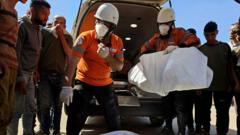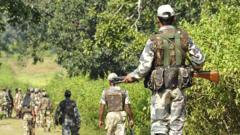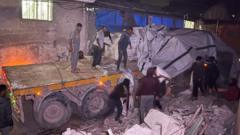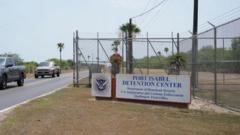With a military coup already causing widespread turmoil, a recent earthquake further exacerbates challenges for the nation.
Myanmar Faces Dual Crises Amid Ongoing Conflict and Earthquake Devastation
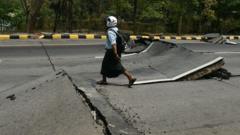
Myanmar Faces Dual Crises Amid Ongoing Conflict and Earthquake Devastation
A powerful earthquake complicates the humanitarian crisis in war-torn Myanmar.
The humanitarian situation in Myanmar has taken a dire turn as a powerful earthquake strikes the country, already reeling from a four-year civil war and severe food shortages. On Friday, the 7.7 magnitude quake struck near the city of Sagaing, a known rebel stronghold, sending shockwaves that reached as far as Mandalay and Nay Pyi Taw, the capital. Reports indicate extensive destruction, but communication has become increasingly difficult; many areas lack electricity and access to the internet, coupled with restrictions on foreign journalists.
Myanmar's path to this crisis has been marked by decades of conflict. Following its independence from Britain in 1948, the nation experienced prolonged military rule. An optimistic shift towards democracy began in 2011, culminating in the landslide victory of Aung San Suu Kyi's National League for Democracy (NLD) in 2015. However, this progress was abruptly halted by a military coup in February 2021, led by General Min Aung Hlaing, who claimed electoral fraud after the NLD secured over 80% of the vote.
The coup ignited widespread protests and violent crackdowns. The military's aggressive response intensified discontent, leading to a full-blown civil war. Thousands have been displaced as fighting continues, leaving civilians struggling for basic necessities. The United Nations reported over 3.5 million people are now displaced, and food insecurity has reached alarming levels. The UN World Food Program warned that rapid inflation has rendered food unaffordable for many, leading to expected cuts in aid critical to over one million individuals.
The earthquake adds yet another layer of suffering for Myanmar's population of about 50 million. Eyewitness reports highlighted the situation in Mandalay, where a local hospital transformed into a mass casualty site due to quake injuries. With both the junta’s military forces and local insurgents battling for control, the extent of the damage remains unclear. A state of emergency has been declared in the affected regions, and for the first time, the military government has requested international assistance, although their commitment to addressing the aftermath is uncertain amid ongoing conflict.
The devastating earthquake not only complicates the humanitarian landscape but poses significant questions about the future stability of Myanmar as it grapples with both natural and human-made disasters.
Myanmar's path to this crisis has been marked by decades of conflict. Following its independence from Britain in 1948, the nation experienced prolonged military rule. An optimistic shift towards democracy began in 2011, culminating in the landslide victory of Aung San Suu Kyi's National League for Democracy (NLD) in 2015. However, this progress was abruptly halted by a military coup in February 2021, led by General Min Aung Hlaing, who claimed electoral fraud after the NLD secured over 80% of the vote.
The coup ignited widespread protests and violent crackdowns. The military's aggressive response intensified discontent, leading to a full-blown civil war. Thousands have been displaced as fighting continues, leaving civilians struggling for basic necessities. The United Nations reported over 3.5 million people are now displaced, and food insecurity has reached alarming levels. The UN World Food Program warned that rapid inflation has rendered food unaffordable for many, leading to expected cuts in aid critical to over one million individuals.
The earthquake adds yet another layer of suffering for Myanmar's population of about 50 million. Eyewitness reports highlighted the situation in Mandalay, where a local hospital transformed into a mass casualty site due to quake injuries. With both the junta’s military forces and local insurgents battling for control, the extent of the damage remains unclear. A state of emergency has been declared in the affected regions, and for the first time, the military government has requested international assistance, although their commitment to addressing the aftermath is uncertain amid ongoing conflict.
The devastating earthquake not only complicates the humanitarian landscape but poses significant questions about the future stability of Myanmar as it grapples with both natural and human-made disasters.


